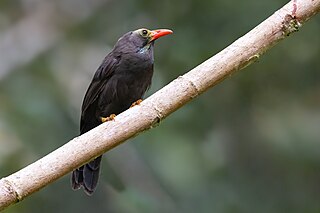Coral-billed scimitar babbler has been split into two species
- Black-crowned scimitar babbler, Pomatorhinus ferruginosus
- Brown-crowned scimitar babbler, Pomatorhinus phayrei
Coral-billed scimitar babbler has been split into two species

The scimitar babblers are birds in the genera Pomatorhinus and Jabouilleia of the large Old World babbler family of passerines. These are birds of tropical Asia, with the greatest number of species occurring in hills of the Himalayas.

Pomatorhinus is a genus of scimitar babblers, jungle birds with long downcurved bills. These are birds of tropical Asia, with the greatest number of species occurring in hills of the Himalayas.

The Indian scimitar babbler is an Old World babbler. It is found in peninsular India in a range of forest habitats. They are most often detected by their distinctive calls which include an antiphonal duet by a pair of birds. They are often hard to see as they forage through dense vegetation. The long curved yellow, scimitar-shaped bills give them their name. It has been treated in the past as subspecies of the white-browed scimitar babbler which is found along the Himalayas but now separated into two species, the peninsular Indian species and the Sri Lanka scimitar babbler.
The Naung Mung scimitar babbler is a bird in the family Pellorneidae, described as new to science in 2005. It is sometimes considered conspecific with the closely-related short-tailed scimitar babbler.

The bare-headed laughingthrush is a species of bird in the Old World babbler family Timaliidae. It is endemic to highland forests at elevations of 750–1,800 m (2,460–5,910 ft) in the mountain ranges of north-central Borneo, along with some outlying peaks. It is 25–26 cm (9.8–10.2 in) long, with both sexes similar in appearance. The head is brownish to greenish yellow and featherless. The area along the lower mandible has a bluish tinge. The rest of the body is dull blackish-brown tinged with grey. Juveniles have more feathers on the head, extending from the forehead to the crown.

The black-crowned scimitar babbler is a species of bird in the family Timaliidae.

The Javan scimitar babbler is a species of bird in the family Timaliidae. It is endemic to Java, Indonesia. The Sunda scimitar babbler, which is found in Sumatra, Borneo, and Malaysia, was formerly considered conspecific, with both species being grouped as the chestnut-backed scimitar babbler. Its natural habitats are subtropical or tropical moist lowland forest and subtropical or tropical moist montane forest.

The red-billed scimitar babbler is a species of bird in the family Timaliidae. It is found in Northeast India, Southeast Asia and adjacent parts of southern China.

The streak-breasted scimitar babbler is a species of bird in the family Timaliidae.

The white-browed scimitar babbler is a species of bird in the family Timaliidae. It is found in Bangladesh, Bhutan, Cambodia, India, Laos, Myanmar, Nepal, Thailand, and Vietnam. Its natural habitats are subtropical or tropical moist lowland forest and subtropical or tropical moist montane forest.

The slender-billed scimitar babbler is a passerine bird in the Old World babbler family. It is found from the Himalayas to north-western Vietnam. Its natural habitat is subtropical or tropical moist montane forests.

The Sri Lanka scimitar babbler or Ceylon scimitar babbler is an Old World babbler. It is endemic to the island of Sri Lanka, and was formerly treated as a subspecies of Indian scimitar babbler. The nominate form is found in the western part of wet hill regions of Sri Lanka, while race holdsworthi is found in the dry lowlands and eastern hills.

The Taiwan scimitar babbler is a bird in the family Timaliidae, the Old World babblers. It is endemic to Taiwan. The species was first described by Robert Swinhoe in 1859. It was formerly treated as a subspecies of the streak-breasted scimitar babbler. Its population is declining, but not rapidly enough for it to be considered vulnerable.

The jungle babblers are a family, Pellorneidae, of mostly Old World passerine birds belonging to the superfamily Sylvioidea. They are quite diverse in size and coloration, and usually characterised by soft, fluffy plumage and a tail on average the length of their body, or longer. These birds are found in tropical zones, with the greatest biodiversity in Southeast Asia and the Indian subcontinent.
Chestnut-backed scimitar babbler has been split into the following species:

The Sunda scimitar babbler is a species of bird in the family Timaliidae. It is endemic to Sumatra, Borneo, and Malaysia. The Sunda scimitar babbler and the Javan scimitar babbler being grouped as the chestnut-backed scimitar babbler. Its natural habitats are subtropical or tropical moist lowland forest and subtropical or tropical moist montane forest.
The brown-crowned scimitar babbler is a species of bird in the family Timaliidae. It is found in Bhutan, India, Myanmar, Thailand, Laos, Vietnam, and China. Its natural habitat is subtropical moist montane forest.